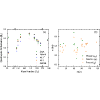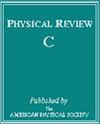Effect of nuclear deformation and orientation about the symmetry axis of the target nucleus on heavy-ion fusion dynamics
IF 3.4
2区 物理与天体物理
Q1 Physics and Astronomy
引用次数: 0
Abstract
Nuclear shape and orientation degrees of freedom are incorporated into the calculation of the double-folding nuclear potential within the relativistic mean-field (RMF) formalism. The quadrupole deformations (), nuclear densities, and the effective nucleon-nucleon () interaction potential are obtained using the RMF approach for the hybrid, , and NL3 parametrizations. The calculated quadrupole deformations are included in the target densities through the nuclear radius. The deformation and orientation-dependent microscopic nuclear potentials are further employed to obtain fusion barrier characteristics and cross sections for 12 even-even heavy-ion reactions with doubly magic spherical and as projectiles along with deformed targets from different mass regions. The results obtained for the relativistic R3Y potential are compared with those of the Reid version of the nonrelativistic M3Y potential as well as with the available experimental data. A decrease in the barrier height and increase in the cross-section is observed upon the inclusion of target quadrupole deformations in the nuclear density distributions at the target orientation angles, for the R3Y potential and at for the M3Y potential. On comparing the -integrated cross section calculated using M3Y and R3Y potentials with spherical and deformed densities, one observes that the deformed densities and the relativistic R3Y potential obtained for the hybrid parameter set provide better agreement with the available experimental data for all the considered reactions. Moreover, the modifications in the characteristics of the fusion barrier and hence in the cross section with the inclusion of nuclear shape degrees of freedom and orientations are found to become more prominent in reactions forming heavier compound nuclei. This implies that the inclusion of nuclear deformations and orientation in the calculation of the microscopic nuclear potential within the RMF formalism is crucial to provide a reliable description of the sub-barrier nuclear fusion dynamics, especially in the heavy and superheavy mass regions.

核变形和围绕靶核对称轴的取向对重离子聚变动力学的影响
核形状和取向自由度被纳入相对论均场(RMF)形式主义的双折叠核势计算中。使用混合、NL3* 和 NL3 参数化的 RMF 方法获得了四极子变形(β2)、核密度和有效核子-核子(NN)相互作用势。通过核半径,计算出的四极子变形被包含在目标密度中。利用变形和取向相关的微观核势,进一步获得了以双魔球 O16 和 Ca48 为射弹的 12 个偶偶重离子反应的聚变势垒特性和截面,以及来自不同质量区域的变形靶。相对论 R3Y NN 势的结果与 Reid 版本的非相对论 M3Y NN 势的结果以及现有实验数据进行了比较。当在 R3Y NN 势的θ2≤58∘处和 M3Y NN 势的θ2≤60∘处的核密度分布中加入靶四极变形时,可以观察到势垒高度降低和截面增大。比较使用 M3Y 和 R3Y NN 势计算出的θ2-积分截面,以及球形密度和变形密度,可以发现混合参数集得到的变形密度和相对论 R3Y NN 势与所有考虑反应的现有实验数据更为吻合。此外,在形成较重化合物核的反应中,核形状自由度和取向的加入对聚变势垒特征的改变以及由此对截面的改变变得更加突出。这意味着在 RMF 形式中计算微观核势时纳入核变形和取向对于可靠描述亚屏障核聚变动力学至关重要,特别是在重质量和超重质量区域。
本文章由计算机程序翻译,如有差异,请以英文原文为准。
求助全文
约1分钟内获得全文
求助全文
来源期刊

Physical Review C
物理-物理:核物理
CiteScore
5.70
自引率
35.50%
发文量
0
审稿时长
1-2 weeks
期刊介绍:
Physical Review C (PRC) is a leading journal in theoretical and experimental nuclear physics, publishing more than two-thirds of the research literature in the field.
PRC covers experimental and theoretical results in all aspects of nuclear physics, including:
Nucleon-nucleon interaction, few-body systems
Nuclear structure
Nuclear reactions
Relativistic nuclear collisions
Hadronic physics and QCD
Electroweak interaction, symmetries
Nuclear astrophysics
 求助内容:
求助内容: 应助结果提醒方式:
应助结果提醒方式:


